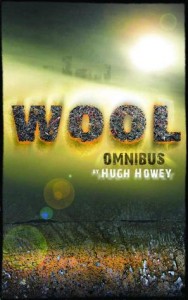 One of the things I admire most about dystopian and fantasy novels is the author’s ability to create a whole other world. Few have done this better than Hugh Howey in Wool, the first book in the Silo series.
One of the things I admire most about dystopian and fantasy novels is the author’s ability to create a whole other world. Few have done this better than Hugh Howey in Wool, the first book in the Silo series.
Capturing the First Sentence
There’s a lot of pressure on a first sentence. You have to create tension and pique the reader’s interest. You have to start the story and literally set the tone. When you’re writing about a world that’s foreign to the reader, you also have to begin immersing them in that world without alienating them.
The children were playing while Holston climbed to his death; he could hear them squealing as only happy children do. – Hugh Howey, Wool
In this first sentence of Wool, Howey creates tension by juxtaposing the impending death of Holston and the joy of the little children. He piques our interest by putting us right there in the middle of the last few moments of Holston’s life. As many writers do, he’s starting this story in medias res and it’s hard not to care that this man (even though we have no idea who he is) is about to die and Howey’s writing about it all so matter of factly, in direct, unadorned language.
Last, but not least, this one sentence is already showing us a world where a person can climb to one’s death and you get the feeling that he’s not mounting a cliff. We don’t know much but we do know that despite this desolate moment in Holston’s life, the world itself is not desolate if it’s filled with happy children.
It’s amazing what just a few words can do.
Imagining a World
What continued to amaze me is how much Howey accomplished on the next couple of pages to immerse me in this world he has created.
Holston could feel the vibrations in the railing, which was worn down to the gleaming metal. That always amazed him: how centuries of bare palms and shuffling feet could wear down solid steel… Each life might wear away a single layer, even as the silo wore away that life. – Hugh Howey, Wool
With this passage, Howey starts to show and tell us about the centuries the people of this world have been there and the effect that time has had on the place. We begin to understand that resources are limited and that the world itself is limited to the confines of this silo.
Alive and unworn, dripping happy sounds down the stairwell, trills that were incongruous with Holston’s actions, his decision and determination to go outside. – Hugh Howey, Wool
This sentence introduces a tension between the inside of the silo and the outside. In a way, we want Holston to go outside because it pulls us free of the confines, but then we remember that he’s on his way to death. Outside means death.
[H]e thought, not for the first time, that neither life nor staircase had been meant for such an existence. The tight confines of that long spiral, threading through the buried silo like a straw in a glass, had not been built for such abuse. Like much of their cylindrical home, it seemed to have been made for other purposes, for functions long since forgotten. What was now used as a thoroughfare for thousands of people, moving up and down in repetitious daily cycles, seemed more apt in Holston’s view to be used only in emergencies and perhaps by mere dozens. – Hugh Howey, Wool
Although inside means life, this passage constricts the world. This further ratchets up the tension. This is also where Howey starts to let loose some real details of what the inside of the silo is like. We understand that it’s underground, not above like we would expect. It begins to sound like a buried office building. Did it get buried? Was it built that way? What happened?
There is so much familiar in this world (the stairs, the children, the glass, the straw) but it’s all (literally) tipped over. By using all of those familiar elements and analogies, Howey’s giving us something to grab onto while he reinterprets how the thousands of people living in the silo interact with those things.
And Holston doesn’t know how the silo got there.
Two pages. Howey has written, by this point, two pages and already I’m enthralled with this new world he’s built. I have to understand how it got there. I have to understand the society and the rules. Most importantly, I have to understand what happens when Holston goes outside.
Self-published Author Makes Good
The story of the publication of Wool is every self-published author’s dream. It started as a short story and it was so popular that Howey began writing (and self-publishing) more and more segments until it was a full-fledged book and then a series. He’s sold the movie rights and now has a relationship with Simon & Schuster. It’s inspiring to see how compelling writing can find it’s way to an audience.
The book is far from perfect (there’s a villain so cardboard I kept waiting to see him twist the long ends of his mustache), but it’s a hell of a read and it’s been a long time since I was so drawn into a world so quickly.
How do you build a world? Or do you have a writer you think does it especially well? I’d love to hear your experiences in the comments.
To learn more about life in the silo, pick up a copy of Wool: Omnibus from Bookshop.org. Your purchase keeps indie booksellers in business and I receive a commission.





Leave a Reply